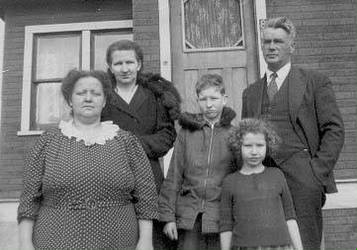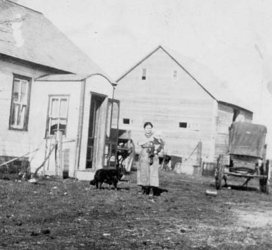I've scattered "sayings" throughout on some of the pages. These are not meant to reflect on any individual, rather they are meant to add interest to the site. I just thought this was a good place to jot these down for the enjoyment of visitors. The source of these sayings are from stuff I have read and saved and some I've heard over the years and oh yeah, I made some up. Don't forget to click on the links further down this page.
Hildebrand is a name ancient in origin and steeped in legend, mystery and history. It probably originated with a Germanic tribe called Langobardi (Longbeards) where names ending in brand were quite common. By linking the Langobardi words Hilti meaning sword or battle and brand meaning flame or burning (as in Forge) the resulting name Hildebrand meant sword of flame or flaming warrior. In time the name varied to include Hildebrandt, Hillebrand, Hiltibrand, Hadubrand and others.
The Langobardi originated around 200 A.D. in the Elbe River Valley in the area of present day Hamburg and by 3-400 A.D. they had migrated to the present day Bavaria-Austria region. In 568 A.D. they invaded Italy, sacked Rome and established their own kingdom along the Po River that bears their name to this day, Lombardy. The ballad "Das Hildebrandslied" was likely sung at court during the reign of a famous Langobardi king, Liutbrand (712-744 A.D.) One of Liutbrand's nephews was named Hildebrand. The ballad was written down by monks at Fulda Germany around 800 A.D. and survives today as the oldest manuscript of German epic poetry. The ballad relates the story of the Knight Hildebrand who deserted his wife and infant son and followed his King in military campaigns. Years later, at one of their battles, Hildebrand was chosen to duel a champion of an opposing army. During the duel, Hildebrand recognized his opponent, Hadubrand, as his estranged son. Hildebrand, being the more experienced, had Hadubrand at his mercy and was prepared to walk away and spare his son's life. Hadubrand,however, enraged by the father who had abandoned him, pressed on leaving Hildebrand no choice but to kill his own son.
Another notable mention of Hildebrand is that of a priest from Northern Italy named Hildebrand who, in 1073, was elected Pope of the Roman Catholic Church. He assumed the title Pope Gregory VII in honour of his old mentor. Another was Johan Von Hildebrand, an Austrian Army Engineer, who built famous baroque palaces including Belvedere in Vienna and The Residez of the Prince Archbishop of Wurzburg. In the mid 1500's a Hiltibrand was listed as one who fled east to escape the wrath of Emperor Charles V of the Netherlands. Hildebrands are recorded as settlers in the Danzig region of West Prussia and among them was Peter Hildebrand of Bohnsack. Peter and his family immigrated to Russia in 1789 in response to an offer from Catherine the Great that presented the possibility for Peter to own land. As the migration of Mennonites continued, in 1803, Heinrich Hildebrand moved from the village of Kliene Wickerau in Prussia to the village of Muensterberg, Molotschna colony in Russia. Heinrich was the great, great, great grandfather of Ed Hildebrand and Ed is the writer of an article that provided many of the foregoing events. Ed's article is titled "Hildebrand. A name for warrior heroes of mythology and pacifist Mennonites. A name for a Catholic Saint and no doubt, many sinners." Most European surnames originated around 1000 A.D. out of necessity to distinguish "John the Miller" from "John the blacksmith" and because records were being kept by churches and organizations such as guilds and nobility. I speculate, however, that Hildebrand was a name as far back as perhaps 300 A.D. and this Family Tree is my attempt to trace the name back as far as possible and to record as complete as possible the following generations thereby giving the present and future bearers of the name Hildebrand a heritage to identify with and to provide them with a sense of belonging.
This branch of the Hildebrand family immigrated to Canada on July 27,1874 from The Halbstadt or Bergthal Mennonite colonys in Ukraine. Peter and his wife Katharina, both age 43 arrived with 8 sons and 2 daughters. They were part of a group of 521 Mennonites and settled in Southern Manitoba East of the Red River.
S.S.PERUVIAN
The "Peruvian". - Built by R. Steele & Co, Greenock in 1863 for the Allan Line, she was a 2549 gross ton ship, length 312.1ft x beam 38.6ft, clipper stem, one funnel, three masts, iron construction, single screw and a speed of 11 knots. There was accommodation for 100-1st class and 600-3rd class passengers. An attempted launch was made on 21/Aug/1863 but she stuck on the slipway and the launch was completed on 31/Aug/1863. She sailed from Liverpool on her maiden voyage to Portland on 31/Mar/1864 and commenced her first run from Liverpool to Quebec and Montreal on 12/May/1864. First voyage from Liverpool to Halifax, Norfolk and Baltimore commenced 11/Aug/1871. In 1874 she was lengthened to 373.1ft, 3038 tons and her engines compounded, and on 14/Jul/1874 resumed the Liverpool - Quebec - Montreal service. The Hildebrand family arrived in Quebec on 27/Jul/1874 and therefore must have been on this first crossing after the lengthening. On 26/Apr/1887 resumed Liverpool - Baltimore service and in 1890- 1891 was fitted with new compound engines and given a second funnel. She commenced a Glasgow - Boston service on 6/Feb/1891 and a Glasgow - New York service on 9/Jun/1893. She commenced her last voyage from Glasgow - New York on 7/Dec2/1894 and resumed Glasgow - Boston run on 18/Jan/1895. On 6/May/1902 she started a Liverpool - St. Johns NF - Halifax run, starting her last voyage on 7/Nov1/1903 and was finally scrapped in Italy in 1905.[North Atlantic Seaway by N.R.P.Bonsor.vol.1, p.310] [Posted to the Emigration-Ships Mailing List by Ted Finch - 8 October 1997] Captain Smith was master of the Peruvian in 1870. [E- mail from Marj Kohli - 10
March 1998]











